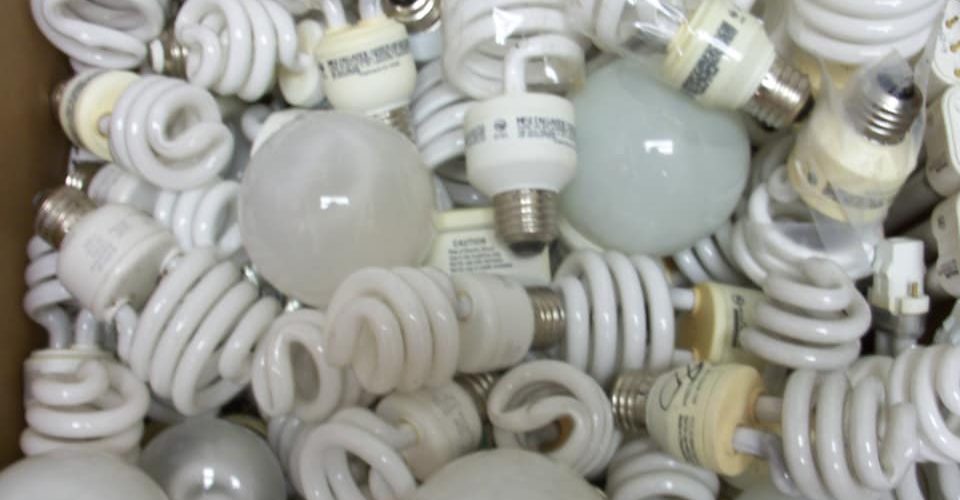Compact Fluorescent Light Guide

Background
Why Compact Fluorescent Bulbs?
Compact Fluorescent Light Bulbs last longer, cost less in the long run, save energy and lessen negative impact on the environment. Research shows that compact fluorescent bulbs use around 75% less energy to produce the same amount of light as incandescent bulbs. Research also shows that the life of compact fluorescent bulbs (up to 10,000 hours) lasts 10 times longer than incandescent bulbs (up to 1,000 hours). When buying a bulb, the cost ($3-$10 per bulb) may seem high but they use about 1/3rd of the electricity of an incandescent bulb. The savings passed on to the consumer in energy can range from $20-$40 during the life of each bulb. An example from the EnergyStar (program run by the Environmental Protection Agency) website states that if each U.S. home replaced one incandescent bulb with a compact fluorescent, the energy savings would be able to light 3 million homes and reduce greenhouse gas emission equal to that of 800,000 cars. An 18-watt replacement would reduce carbon-emissions by 110 lbs per year; a 27-watt replacement would reduce carbon-emissions by 140 lbs per year. It’s estimated that if every home in the U.S. replaced five incandescent bulbs with compact fluorescents it would reduce greenhouse gas emissions by 1 trillion lbs, an energy savings of around $6 billion.
Science
Why Do Compact Fluorescent Bulbs Use Mercury?
Compact Fluorescent bulbs do use Mercury. The small amount of mercury, between 4 and 6 milligrams per bulb, are not enough to pose a serious hazard to your health or environment even in the circumstance that one breaks. Compact Fluorescent’s are glass tubes filled with gas and a small amount of mercury. The mercury molecules in the tube react when electricity runs between the two electrodes at the bottom of the bulb. The Mercury then emits ultraviolet which becomes visible. This is the reason compact fluorescents are more efficient than incandescent bulbs. Incandescent bulbs produce light by heating the filament inside the bulb which when reaches a certain temperature lights the filament which becomes visible. The issue is that most of the electricity is lost heating the bulb instead of transferring electricity.
Related Information
What to do if a Compact Fluorescent Bulb Breaks?
If you do break a bulb, check out this resource from US EPA on how to clean-up the bulb and manage the materials.
Recycling Resources
- http://www.homedepot.com – Home Depot has begun accepting old CFL’s in all of their North American stores. Simply take your unbroken bulbs to the returns counter and from there they will be recycled. To read the press release go to http://www6.homedepot.com/ecooptions/stage/pdf/cfl_recycle.pdf.
- https://www.thinkgreenfromhome.com/ThinkGreenFromHome.cfm – Waste Management offers a cheap service to recycle CFL’s as well as batteries. For a small fee WM will mail you a prepaid package for your CFL’s or batteries that you can then mail back to them for recycling.
- http://www.aerc.com – AERC, Macon-based mercury recycling facility. AERC can arrange pick-up in Alabama, Georgia and South Carolina with EPA registered transporters.
- www.lightingresourcesinc.com – Lighting Resources LLC in Kennesaw, Georgia
- www.ikea.com – Ikea accepts and recycles CFL. Check Customer Service for more information.
- http://www.lamprecycling.com/ – Easypak, online recycling company that offers containers for bulbs, lamps, batteries, ballasts and electronics. The fee includes; the container, shipping to the recycling center, recycling fees and certificates of recycling.
- http://www.mkcenterprises.com/ – MKC Enterprises, Atlanta-based environmental specialists who can arrange pick-up by appointment only most household hazardous waste.
- http://www.recyclebulbs.com/ – Southeast Recycling Technologies, Tennessee-based recycling group that specializes in recycling mercury containing lamps and equipment as well as batteries, ballasts and electronics. Services all of TN, NC, VA, GA, KY, AR, along with North MS and North AL.
- www.wmlamptracker.com – Waste Management, WM’s website offers patented vapor lock storage containers that can be shipped to a home or business for CFL’s, CFB’s, batteries, ballasts, medical and electrical devices, computer and electronics and dental amalgam.
- http://veoliaes-ts.com/recyclepak – Veolia Environmental Services offers a mail order container system for CFL’s, lamps, and other mercury containing devices.
Mail-Back Programs: Some companies provide mail-back options for recycling bulbs. To learn more about mail-back programs, visit the US EPA lamp recycling and disposal web page at tinyurl.com/bdffzu37.
